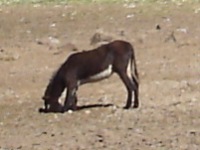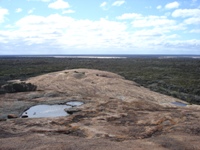Australia So Much to See


Collecting water when not staying at caravan parks
Most travellers find they can easily fill tanks with adequate supplies from conventional sources such as caravan parks and fuel service
stations. We need to refuel the tow vehicle far more often than we need to fill water tanks, and if needing to fill the tanks
I always ask before getting fuel. Not all water outlets are suitable for fitting a hose and they may be in a place where stopping
to fill tanks would block the flow of traffic through the bowsers. If you cannot find a suitable source, ask at the Visitor
Information Centre or Shire office if there is anywhere you can obtain water to top up the tanks. In some areas where water
is scarce, there may not be anywhere suitable or there may be a fee for the water. We were at a mechanic’s workshop in a
Carry a food grade hose
and always use your own hose. Sometimes a garden hose that has been in the sun can taint the water. Semi clear hoses can
be obtained from hardware stores such as Bunnings. It does not need to be a fully lined hose as water flowing through the hose
will not pick up any taste from a regular food grade hose. The higher quality lined hose is only recommended for places where
water may remain in the hose for some time.
There may be times when water must be collected from other sources such as rivers,
streams, lakes or dams. This can be transported by bucket, jerry can or water bladder, but to fill the latter you will need
a pump.
Travellers who remain in one place for any length of time where water on tap is not available will prefer to fill their tanks to enable regular use shower and taps. My keeping it simple method of bringing water in a bucket instead of filling the tanks is more suited to sort term camping. Regardless, it is not a good idea to risk putting dirty or contaminated water into your tanks so those needing to do so use quality filters.
Methods can vary from complex filtration systems to ensure good quality
water in all tanks, under the tap filters so that only drinking and cooking water is filtered or using filter jugs to improving
the drinking quality of small quantities of water.
Filters can be purchased ranging from the simple replaceable cartridges to
remove sediment, through to expensive filtration systems that remove bacteria, parasites and other contaminants.
Reverse osmosis systems
produce water free of biological contaminants and virtually free of chemical contaminants.
Water sterilising tablets such as these will remove the risk of bacteria but will not help if chemicals are present. You are also ingesting another chemical. More expensive, but suitable for treating a lot of water safely is Micropur. These are examples of products available.
To fill tanks through a filter from an outside water source such as a stream or lake will require the pressure of a pump. This can be a 12 volt pump similar to those used for delivering water to the caravan taps, with a suitable power source; either to caravan power system or another battery (even the tow vehicle battery) if pump is used near the water source. Alternatively 12 volt shower or marine bilge pumps will suffice and these can be purchased economicially from camping stores and from eBay.
If
you are unable to pump the distance from the source, water can be brought in buckets to the caravan and pumped into the tanks through
the filter from the bucket, however this work will ensure you are very water wise.
If you are lucky enough to experience good rain
when needing water, after the dust has been rinsed off, the annex makes a good collector with water being caught in buckets and delivered
into the tanks with a funnel, or a bucket with a hose attached to a hole in the bottom, secured high enough to conduct the water into
the tanks. Even without an annex, when the caravan has had a good rinse, look for the lowest corner and collect the stream of
water with buckets. Even if you only fill up water jerry cans and drinking bottles, this rain water can help tide you over until
another water source is found. Should any remaining dust find its way into your collected water, it will settle when left standing.
In a worst case scenario of becoming stranded with no water or food, humans can survive weeks without food, but on last days if without
water. Many people have died in remote Australian areas over the years, including some tourists from overseas.
If you are in areas with large or flat granite rock outcrops, check for water collection points on the rocks. Gnamma holes on granite rocks can sometimes hold water long after rain.
Water can collect in the hollows of trees and insect or small bird activity
may be an indication.
Look for animal tracks that converge as they may lead to a soak or water source. Flocks of birds will also go to water sources.
Dig in the sand of water courses; location of vegetation will be a guide to the most likely places.
Emergency
methods which may be suitable for gathering a small quantity to sustain life, depending on what is around:
Saline water or stagnant
can be evaporated over a heat source and the steam condensed and collected.
Water can be drained from branches, roots or vines
in some cases. Milky sap is not suitable and may be poisonous or corrosive. Bark of some trees such as paper bark (Melaleuca)
can hold bubbles of water which can be extracted.
Condensation can be collected by putting a plastic bag over a shrub
with green leaves in sunlight and placed so the condensation can trickle into a container. A condensation pit can be made filled
with vegetation and a plastic sheet stretched across it with a container under it at the lowest point.
The survival website linked
has ideas on water collection in extreme circumstances as well as what can be eaten in the bush.

